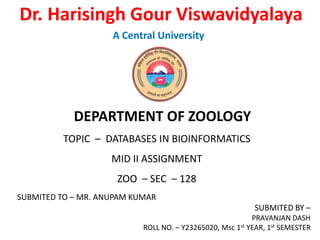
BIOINFORMATICS AND DATABASES IN BIOINFORMATICS.pdf
- 1. Dr. Harisingh Gour Viswavidyalaya A Central University DEPARTMENT OF ZOOLOGY TOPIC – DATABASES IN BIOINFORMATICS MID II ASSIGNMENT ZOO – SEC – 128 SUBMITED TO – MR. ANUPAM KUMAR SUBMITED BY – PRAVANJAN DASH ROLL NO. – Y23265020, Msc 1st YEAR, 1st SEMESTER
- 2. INTRODUCTION OF DATABASE BIOLOGICAL DATABASES are Collection of files containing records of biological data in machine readable form Can be accessed, added, retrieved, manipulated and modified. Store, manage, connect and distribute data. Data are arranged by sets of rules which are programmed into software that manages the data called Database Management System or DBMS. A biological database is a collection of data that is structured, searchable, updated periodically and cross referenced. The data is stores, maintained, annotated, curated and stored for public/research use. Data collected and organized in a specific but useful way
- 3. Classification based on type of data stored Primary Databases: Contain original data in the form of primary sequence data or structural data as submitted by the scientific community. Secondary Databases: Contain information that has been processed and derived from the raw data available in primary database.eg: PROSITE, PRINTS, BLOCKS etc.. Composite Databases: Collect and present data after comparing and filtering them from different primary databases and exhibit only the non redundant sequences.
- 4. PRIMARY DATA VERSUS SECONDARY DATA PRIMARY DATA • Primary data is a type of data researchers directly collect from main sources. • Includes real-time data. • Collected to address a current research problem. • Accessing primary data includes a relatively long process. • Data collection tools include observations, surveys, questionnaires, physical testing, online questionnaires, personal or telephone interviews, case studies, and focused group discussions. SECONDARY DATA • Secondary data refers to already existing data produced by the previous researchers. • Related to the past. • Primarily collected to address previously existed research problems and can be used to address the current research problem as well. • Referring to secondary data is quick and easy. • Data collection tools include journal articles, websites, books, government publications, records, etc.
- 5. PRIMARY DATABASES Primary databases contain original biological data. They are archives of raw sequence or structural data submitted by the scientific community. Once given a database a accession number, the data in primary database are never changed. There are three (Genbank, EMBL, DDBJ) major public sequence databases that store raw nucleic acid sequence data produced and submitted by researchers worldwide. SOME PRIMARY DATABASES Nucleic acid databases: Gen Bank, EMBL, DDBJ Protein sequence databases: PIR, Swiss-Prot, UNIPROT Protein structure database: PDB Metabolic databases: KEGG
- 6. SECONDARY DATABASE • Secondary database contain additional information derived from the analysis f data available in primary sources. econdary databases are analysed in a variety Of ways and contain different formation in different formats. • SOME SECONDARY DATABASES ARE TrEMBL Pfam PROSITE Profiles SCOP CATH
- 7. NUCLEOTIDE SEQUENCE DATABASE • Composed of a group of nucleotide sequence entries. • Data repositories that accept nucleic acid sequence data and make it freely available to the public. • All the three are members of the International Nucleotide Sequence Database Consortium (INSDC) and interchange data. • GenBank, EMBL, DDBJ are principal nucleotide databases.
- 8. PROTEIN SEQUENCE DATABASES An array of amino acid sequence entries arranged according to the identification number. Well known protein sequence databases available on www are Swiss-Prot PIR UNIPROT
- 9. PROTEIN STRUCTURE DATABASE Many proteins which exhibit a common evolutionary origin, show structural similarities. Dissimilar proteins exhibit changes in primary, secondary, teritiary and quarternary structures. Similar or dissimilar protein structure can be predicted with structure database. These databases store a collection of three dimensional structures of proteins. EXAMPLE IS pluggable database (PDB) .
- 10. THANK YOU